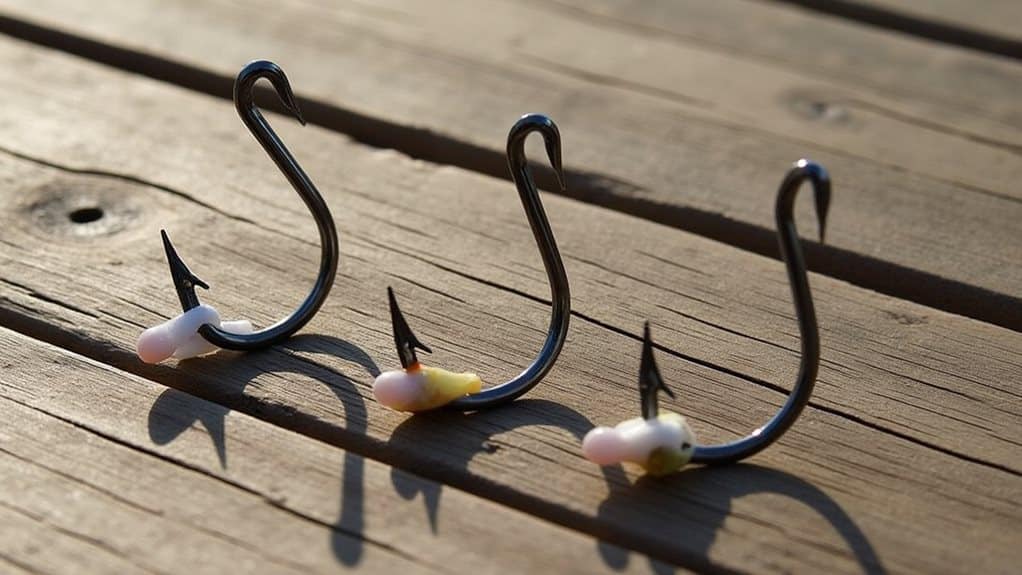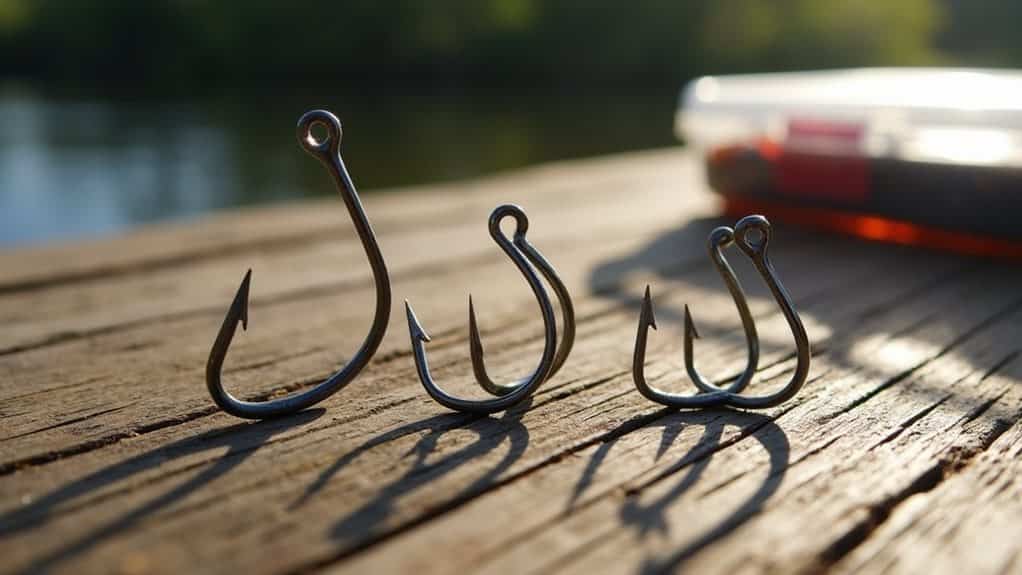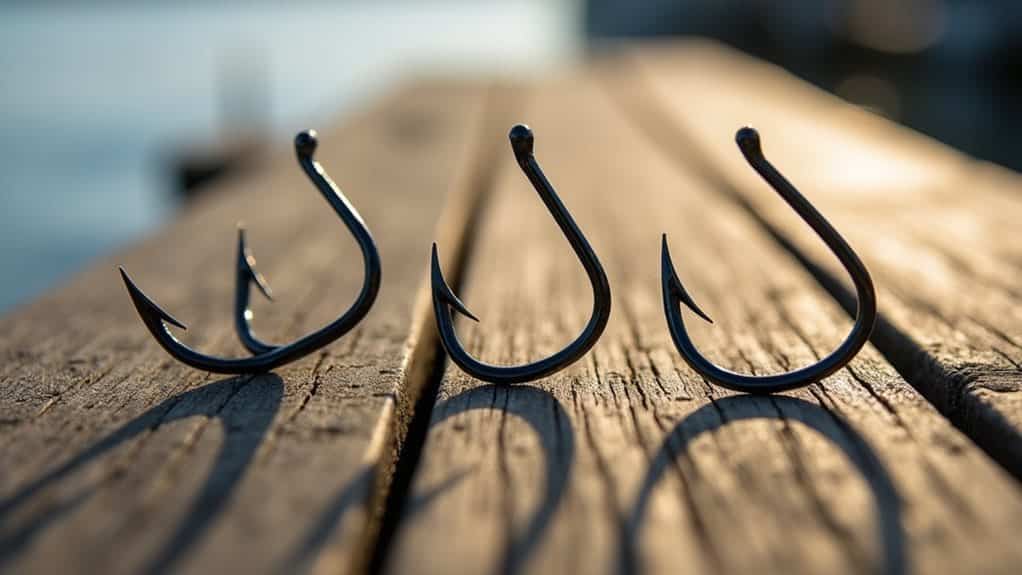For largemouth bass, you’ll want to use hooks ranging from 1/0 to 3/0 as your primary sizes, though specific conditions may call for adjustments. Match smaller 1/0 hooks with finesse presentations and spring fishing, while larger 3/0 hooks work better for summer and bigger baits. Choose thin wire hooks for lighter lines and medium-action rods, and adjust your hook size based on your bait selection. Understanding these subtleties will greatly improve your success on the water.
TLDR
- The ideal hook sizes for most largemouth bass fishing range from 1/0 to 3/0, with larger hooks for bigger baits.
- Use 3/0 to 5/0 wide gap hooks for Texas rigs with large baits, and 2/0 or 3/0 for smaller worms.
- Match smaller hooks (1/0 to 2/0) during spring and winter, switching to larger hooks (3/0) in summer.
- For finesse presentations and drop shotting, select 1/0 or smaller hooks for better bait movement.
- Choose hook size based on bait size: 1/0-2/0 for small worms, 3/0 for medium plastics, 4/0-5/0 for larger baits.
Understanding Hook Sizing for Bass Fishing

When you’re getting started with bass fishing, understanding hook sizes can seem like learning a new language, but it’s actually quite straightforward once you grasp the basics. The sizing system runs inversely for smaller hooks (smaller numbers mean bigger hooks), while larger hooks use the “aught” system (2/0, 3/0, etc.). For largemouth bass, you’ll typically use medium-sized hooks ranging from #6 to 3/0. It’s important to match your hook thickness to your rod power, as thin wire hooks work best with lightweight lines and medium light-action rods. Additionally, selecting the right hook size can significantly impact your success in competitive fishing tournaments, as it affects your ability to catch larger fish.
Popular Hook Sizes for Different Bass Techniques
When you’re selecting hooks for bass fishing, you’ll find that Texas rigs typically work best with 3/0 to 5/0 wide gap hooks depending on your worm length. If you’re drop shotting, you’ll want to scale down to a 1/0 or even smaller hook to maintain the finesse presentation needed for this technique. Additionally, utilizing the right fishing hot spots can significantly enhance your chances of success. Your hook selection directly impacts your success rate, so matching the hook size to both your bait and fishing technique will greatly improve your chances of landing more bass. For optimal performance and durability, consider using hooks from VMC Redline Series, which are specifically designed for bass fishing applications.
Texas Rig Hook Selection
Selecting the right hook size for your Texas rig setup stands as one of the most essential decisions you’ll make when targeting largemouth bass.
For larger baits like brush hogs and creature baits, you’ll want 3/0 to 5/0 hooks, while smaller worms work best with 2/0 or 3/0.
When fishing heavy cover, choose sturdy offset worm hooks or EWG designs with thicker wire gauges.
Drop Shot Hook Types
Beyond the Texas rig setup, drop shot fishing has emerged as a highly effective technique for catching largemouth bass.
You’ll want to match your hook size to your bait: use size #1 to #2 hooks for finesse fishing with smaller baits, and switch to 1/0 to 3/0 hooks for power fishing with larger baits.
Quality brands like Gamakatsu and Owner offer specialized drop shot hooks that’ll enhance your success.
Matching Hook Size to Your Plastic Baits

The art of matching hook size to plastic baits can make or break your bass fishing success. For small finesse worms, you’ll want to stick with 1/0 or 2/0 hooks. Medium-sized 4- to 5-inch plastics pair well with 3/0 hooks. When you’re fishing larger baits like 8- to 12-inch worms or bulky creature baits, step up to 4/0 or 5/0 hooks for ideal hooksets. Additionally, it’s essential to consider fishing regulations in your area to ensure compliance while targeting bass.
Best Hook Choices for Topwater Fishing
When fishing topwater lures for largemouth bass, choosing the right hook setup can dramatically improve your success rate on the water.
You’ll want to use 1x or 2x strong treble hooks for most applications, with Owner ST36 and ST56 being reliable choices.
For larger lures, consider upgrading to 3x strong hooks, and don’t forget that round bend styles offer better hook-up ratios. Additionally, understanding tide influences can help you select the best times to fish and improve your chances of landing a big catch.
Hook Selection for Texas and Carolina Rigs

Selecting appropriate hooks for Texas and Carolina rigs can greatly impact your bass fishing success, as each rigging style demands specific considerations for ideal performance.
For Texas rigs, you’ll want wide-gap hooks, using 2/0 to 3/0 for smaller baits and 4/0 to 5/0 for larger ones.
Carolina rigs typically require larger concentrated hooks (3/0 to 5/0) since they’re dragged along the bottom.
Drop Shot and Finesse Hook Sizing Guide
Moving beyond Texas and Carolina rigs, drop shot and finesse fishing require a more subtle approach to hook selection.
You’ll want to match smaller hooks (#8 to #1) with lighter lines for finesse presentations, while power drop shot setups demand larger hooks (1/0 and up) with heavier lines.
For best results, pair your hook size with your bait – use #4 hooks for 4.5″ baits and 1/0 for 6″ presentations.
Hook Sizes for Various Bass Fishing Conditions

The diverse conditions you’ll encounter while bass fishing demand specific hook choices to maximize your success on the water.
When fishing heavy cover, opt for heavy wire hooks that won’t bend under pressure.
In clear water, choose lighter, less visible hooks to avoid spooking fish.
For rocky bottoms, you’ll need sturdy hooks with sharp points, while wooded areas call for weedless designs to prevent snags.
Essential Factors in Choosing Bass Hook Sizes
When you’re choosing hook sizes for largemouth bass, several key factors will determine your success on the water.
Consider your bait type, as soft plastics need smaller hooks to maintain natural movement, while solid-body baits can handle larger sizes.
You’ll also want to match your hook’s thickness to your rod and line strength, and make certain the hook size aligns with your target fish’s mouth dimensions.
Hook Size Impact on Bass Strike Rates

Selecting the right hook size directly influences your success rate when targeting largemouth bass, as research shows these fish respond differently to various hook dimensions.
You’ll find that smaller hooks often lead to higher strike rates because they’re less intimidating to fish and match natural prey sizes better.
Additionally, research indicates that using smaller hooks can improve inhalation rates while reducing the risk of deep hooking.
Seasonal Hook Size Adjustments for Bass
Building on your understanding of hook sizes and strike rates, successful bass fishing requires adapting your hook selection to match seasonal changes.
You’ll want to use smaller hooks (1/0 to 2/0) in spring’s clear waters and winter’s slower conditions, while switching to larger hooks (3/0) during summer when bass are more active.
During fall, you’ll need both sizes as conditions fluctuate.
Common Hook Size Mistakes to Avoid

You’ll find that matching your hook size to both your bait and target species is vital for successful largemouth bass fishing.
When you’re selecting hooks, consider not only the size of your bait but also how the hook will affect its action in the water, as an oversized hook can destroy the natural movement that attracts bass.
For best results, you should pair small hooks (1/0 to 3/0) with finesse baits and larger hooks (4/0 to 6/0) with bulkier selections, ensuring your presentation remains natural while maintaining solid hookup potential.
Matching Hook With Bait
When matching hooks with your bass fishing baits, the most essential mistakes often stem from overlooking the relationship between hook size and bait characteristics.
You’ll want to guarantee your hook’s gap is at least double the bait’s diameter, and match the hook’s strength to your gear.
Don’t force large hooks on small baits, as this’ll reduce action and effectiveness while potentially compromising your presentation.
Proper Sizing by Species
Successful bass fishing hinges largely on selecting the right hook size for your target species, with most largemouth bass anglers finding their sweet spot between 1/0 to 3/0 hooks.
Don’t make the mistake of going too large, as this can deter smaller bass, or too small, which might lead to lost fish.
Match your hook’s wire gauge to your line strength, and guarantee the gap accommodates your chosen bait properly.
Final Note
When choosing hooks for largemouth bass, you’ll find that sizes 2/0 to 5/0 cover most fishing situations effectively. Match your hook size to your bait style and fishing conditions, remembering that bigger isn’t always better. Consider downsizing during tough bites and upsizing for larger baits or heavy cover. With proper hook selection, you’ll improve your hook-up ratio and land more bass consistently throughout the season.




